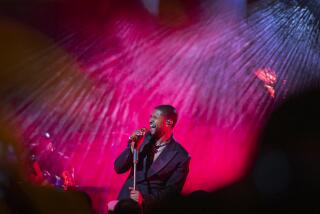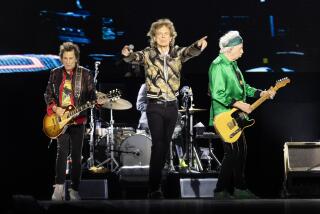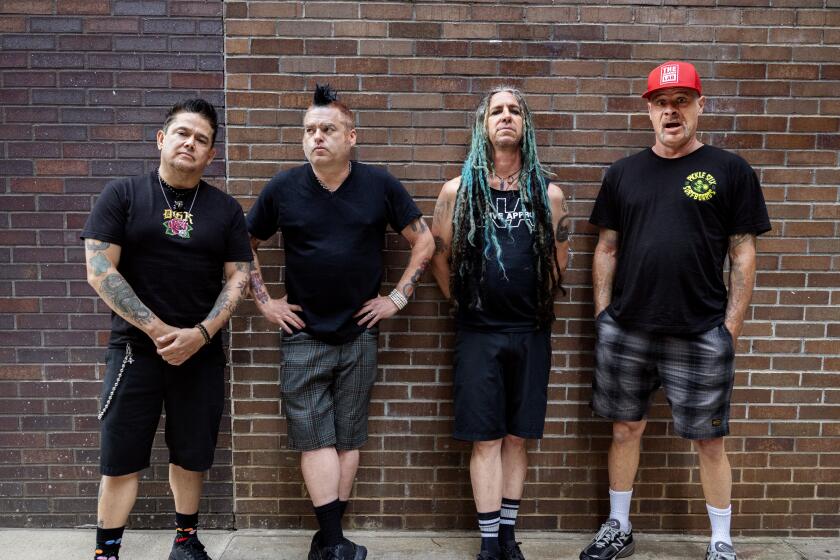POP MUSIC REVIEW : Steve Winwood Comes Alive at Amphitheatre Concert
COSTA MESA — Steve Winwood’s career may have rebounded in 1986 with the hit-spawning “Back in the High Life” album, but the real comeback appears to be taking place on stage on his current tour, judging from his heated, highly musical performance Friday at the Pacific Amphitheatre (he also appeared Saturday at the Forum).
In the years between Traffic’s ‘70s heyday and “High Life,” Winwood’s solo albums reached only a limited audience and his nearly nonexistent public appearances gave him a reputation as a recluse. That was all changed by the effervescent “Higher Love” and other ’86 hits, along with a new, spruced-up, dapper, Robert Palmer-like image for Winwood as he sauntered through stylish videos.
Winwood’s new songs then may have seemed just a bit overprogrammed and short on personality on record, but those recordings seemed far more alive, oddly, than his concert performances. Backed on those tours by a large band and singers delivering slick, rote arrangements with little room for change, Winwood seemed a reluctant frontman, with his stage moves often seeming awkward and forced. If he was finding much pleasure in performing, he sure wasn’t conveying it.
In recent interviews, Winwood has confirmed his discomfort in those overpolished shows and said he was putting the emphasis on playing live music this time out. And, lo and behold, he actually meant it: Friday’s show opened with a shouting, raging version of his 1967 Spencer Davis Group hit “I’m a Man,” with Winwood looking happier than he has in years as he wrenched thick, snarling swells of sound from his Hammond B3 organ.
In the nearly two-hour show that followed, the intensity may not have entirely been up to that incandescent opening, but it nearly always proved vital and alive. Winwood covered a lot of musical ground in his 17 songs, from the raw British R&B; of his Spencer Davis days, through Traffic’s jazz-rock excursions, to the synth-driven dance grooves of his more recent albums.
The consistent factors throughout were the 43-year-old singer/multi-instrumentalist’s disarmingly soulful voice and unerring musical sensibilities, which piloted his responsive five-piece band through some roiling waters.
Winwood’s hair is nearly back to its hippie-days length and the GQ look was replaced by jeans and a loose, colorful beach shirt. And though he may have been standing behind his blocky Hammond keyboard much of the time, the stage moves were genuine, propelled by the music. Compared to his previous stiff, lifeless tours, Winwood himself seemed more loose and colorful, singing with reborn feeling and soul, and with the music flying freely between him and his musicians.
Even on such fare as “Another Deal Goes Down” from his generally lackluster current “Refugees of the Heart” album, his chunky organ fills reminded that this is the same guy whose incredibly intuitive exchanges with Jimi Hendrix on “Voodoo Child” had created a Jupiter-dense atmosphere of sound.
Synthesizers may have yet to match the expressiveness of the Hammond, But Winwood comes as close to attaining that as anyone. He originated some of the now-industry-standard synth patches, and the trademark solo tone--part soprano sax and part pure invention--he applied to “While You See a Chance” and “The Finer Things” spoke like a voice.
And Winwood’s actual voice remains a wonder. In his mid-teens he had achieved an almost frightening mimicry of Ray Charles--not at all the thing one expects to hear out of a pale, acned Brit. It didn’t take him long to develop that into a distinctive, albeit cooler, style of his own, blending that American soul with a reedy, wistful quality that bespeaks his homeland. That, refined by decades of experience, was what he offered on “Higher Love” and his mandolin-accompanied “Back in the High Life” Friday.
In drummer Russ Kunkel, guitarist/keyboardist Larry Byron, saxman Randall Bramlett, bassist Michael Rhodes and percussionist Luis Conte, Winwood has a group that truly plays live, capable of responding to his every nuance. And that makes all the difference in the world. Even on songs which weren’t notably different from the recorded versions, just the possibility they could change, the fact that the members were really listening to each other, gave tunes such as “A Fine Line” and “Valerie” a fresh edge.
The real acid test for the band was the show’s middle section of Traffic songs, numbers strongly reliant on a cohesive musical personality winding through their open-ended improvisations. The players were with Winwood at every step as he explored “The Low Spark of High-Heeled Boys” and the Les McCann-inspired instrumental “Glad” with his grand piano. Both numbers spread out with a spaciousness and freedom that is all too rare in music these days.
Winwood switched to guitar for some snaking solos on a funky workout of “Medicated Goo.” Rounding out the Traffic segment was the Dave Mason-penned “Feelin’ Alright,” space which, if one might quibble, could have been better occupied by “John Barleycorn,” “Dear Mr. Fantasy,” or any number of other Winwood songs.
The show finished on the high note it began with, as Winwood reached back to his Spencer Davis days--this time with a rave-up version of “Gimme Some Lovin’ “--with his voice and that all-time killer organ riff roaring with all the urgency he first poured into it when he was a 16-year-old Wunderkind.
The sound suffered from the usual post-disco failings, meaning that the soundman evidently thought that everybody’s tickets read “snare drum” with “bass lick” instead of “Steve Winwood.” The lighting, however, was impressive throughout. In flashier moments, that included a ‘60s-like oil-gel light show and filmed footage of Winwood’s early Traffic days. More typically, the lighting involved cloaking a semicircle of black drapes in rich, mood-supporting hues while the band was lit in white with small accents of color.
Opener Robert Cray can be a frustrating performer. Caught on the right night, he clearly is one of the most exciting things to happen to blues in decades, with a refreshing blend of Memphis soul and blues roots delivered with passion and a singular style. On other nights, as was the case Friday, his flame burns just a little too cool to ignite the songs.
His seven-selection, 40-minute performance seemed more like the warm-up in a three-set club gig: It left the impression he was saving his best songs and effort for a later time, which, of course, never came Friday.
If his set--which drew heavily from last year’s “Midnight Stroll” album--didn’t catch fire, Cray at least kicked up some sparks in places. “The Things You Do to Me” was a sultry soul ballad well suited to the pliant plaints of his voice, while the ’86 hit “Right Next Door (Because of Me)” allowed a splendid example of his guitar style. On it, his fingers skittered over the strings of his Stratocaster in imaginative, nearly whimsical runs which then unexpectedly slid into stinging, killer-bee bent notes that showed he meant business.
More to Read
The biggest entertainment stories
Get our big stories about Hollywood, film, television, music, arts, culture and more right in your inbox as soon as they publish.
You may occasionally receive promotional content from the Los Angeles Times.










